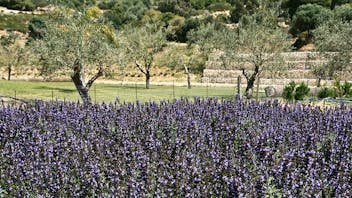Product Overview
The fresh, balsamic, almost forest-like, cooling and at the same time warm aroma of our organic Rosemary ct Verbenone is, in a word, beautiful! The nuances of its finely balanced aroma can be attributed in part to traces of volatile nitrogen compounds of high odor intensity, occurring in concentrations from less than one part per billion to the parts per million range.[1] A true example of the potency of the kingdom of plants and their essences – no wonder they elicit our grateful respect.
The designation of chemotypes (ct) of an essential oil is necessary when distinctly different chemical compositions of the same species are produced; due to their different compositions, these oils can be applied to varying purposes. In the aromatherapy market, Rosemary essential oil appears as one of three main chemotypes – cineole, camphor or verbenone – each of which has different applications. Oils listed simply as “Rosemary” are suspect for highly profitable adulteration.
The most commonly used chemotype is Rosemary cineole, a popular oil for invigorating massage oils, cleansing scalp blends, and for refreshing the senses in diffusers. Rosemary verbenone chemotype is meant for more specialty applications in clarifying skincare formulations and chest rubs.
Ketones in general and verbenone in particular are known solvents of minute molecular size. This Rosemary is best used sparingly for aromatherapy or applied topically after appropriate dilution.
Rosemary is a well-known herb native to the Mediterranean region, abundantly growing wild in Spain, France, Corsica, Italy, Sardinia, all states of the former Yugoslavia, Russia, Turkey, the Middle East, Libya, Tunisia, Algeria, Morocco, etc.[2] The odor character of Rosemary oil varies according to where the plants grow (altitude and climate), what plant parts are distilled, and whether the plant material is fresh or dried when distilled.[3] The plant was sacred to the ancient Greeks and Romans who used it as a symbol of regeneration and employed its aromatic qualities in incense.[4]
1 Boelens, M.H. "Chemical & Sensory Evaluation of Trace Compounds in Naturals," in Proceedings of the 13th International Congress of Flavors, Fragrances and Essential Oils, Istanbul, Turkey, Baser, K.H.C. (ed), 3, 177.
2 Arctander, Steffen. Perfume and Flavor Materials of Natural Origin, 1960, pp. 557-8.
3 Poucher, William A. Perfumes, Cosmetics & Soaps, 1930, p. 310.
4 Aromatherapy for the Family, Jan Kusmirek, ed., 1992, p. 47.



